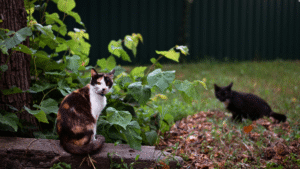If you’ve ever watched your cat gracefully leap over the fence or squeeze through what seemed like an impossibly small gap, you know how frustrating it can be to keep them safely contained in your yard.
Cats are naturally curious, agile, and adventurous — traits that make them wonderful companions but also notorious escape artists.
Whether your goal is to give your cat outdoor time without worrying they’ll wander off or to prevent potential dangers like cars, predators, or getting lost, learning how to stop your cat from escaping the yard is essential.

Why Cats Escape The Yard
Before we dive into solutions, it’s important to understand why cats try to escape in the first place. Knowing their motivations will help you choose the best approach for your cat’s personality.
-
Natural Curiosity:
Cats are explorers by nature. The sights, sounds, and smells beyond the fence are incredibly tempting. Birds, insects, or even a rustling leaf can be enough to spark their hunting instincts. -
Mating Instincts:
Unneutered or unspayed cats are more likely to roam in search of mates. This is one of the most common reasons cats leave their yard, especially in spring and summer. -
Territorial Behavior:
Cats may want to patrol a larger area or chase off perceived intruders like neighboring cats. -
Boredom and Lack of Stimulation:
A bored cat will seek adventure. Without enough toys, climbing spots, or enrichment, they’ll go looking for excitement elsewhere. -
Fear or Stress:
Loud noises, dogs, or unfamiliar people can startle a cat, prompting them to bolt and seek safety.
Once you understand why your cat is escaping, you can take steps to make your yard both secure and appealing enough to keep them content.
Step 1: Secure The Perimeter
The first and most obvious step in stopping your cat from escaping the yard is fortifying your boundaries. Cats are excellent climbers and jumpers, so standard fencing often isn’t enough.
1. Install Cat-Proof Fencing
A cat-proof fence is specifically designed to prevent cats from climbing over or squeezing through gaps. There are a few popular options:
-
Cat Fence Rollers: These are rotating bars that attach to the top of your fence. When a cat tries to climb over, the roller spins, preventing them from getting a grip.
-
Overhang Barriers: Add angled mesh or netting that tilts inward at the top of the fence. Cats attempting to climb will find it impossible to continue upward.
-
Full Cat Containment Systems: Some companies sell entire fence systems with flexible mesh that can be attached to your existing fence or built from scratch.
2. Seal Gaps and Weak Points
Check for small openings near gates, under fences, or where fences meet walls. Cats can squeeze through surprisingly narrow spaces. Use chicken wire, lattice, or garden mesh to close any gaps.
3. Add Height
Cats can jump up to six feet or more. If your fence is low, consider adding extra height with trellis panels or mesh extensions.

Step 2: Create A Cat-Friendly Yard
Once your yard is secure, the next step is to make it so enjoyable that your cat doesn’t want to leave. A stimulating environment helps reduce boredom and the urge to roam.
1. Build a Cat Enclosure or “Catio”
A catio is an enclosed outdoor space attached to your home or set up in the yard. It allows your cat to enjoy the outdoors safely while being fully contained. You can buy pre-made catios or build one yourself using wire mesh and wood frames.
2. Provide Climbing and Hiding Spots
Cats love to climb, perch, and observe their surroundings from above. Add:
-
Cat-safe trees or shelves
-
Outdoor cat towers or platforms
-
Covered hideaways like small boxes or cat houses
These features keep your cat entertained and engaged without the need to escape.
3. Plant Cat-Friendly Vegetation
Create a small garden area with cat-safe plants such as catnip, catmint, and wheatgrass. Avoid toxic plants like lilies, azaleas, and tulips.
4. Offer Shade and Water
Ensure your yard has shaded areas, especially in summer, and provide fresh water to prevent overheating and dehydration.

Step 3: Supervise Outdoor Time
If your cat is new to outdoor exploration, supervision is key. Many cat owners find that controlled outdoor time helps reduce escape attempts.
1. Use a Cat Harness and Leash
Not all cats will take to walking on a leash right away, but with patience and training, it can be an excellent solution. Use a secure harness (never a collar) and start with short sessions.
Related:How To Train Your Cat To Walk On A Leash
2. Try a Cat Playpen
Portable outdoor cat playpens or tents provide a safe, enclosed space for your cat to enjoy fresh air without risk.
3. Gradually Increase Freedom
Allow your cat more space over time as they get used to staying in the yard. Reward them with treats and praise when they stay within boundaries.
Step 4: Address Behavioral Triggers
Even with physical barriers, some cats remain determined to escape. Understanding their behavior can help you address the root cause.
1. Neuter or Spay Your Cat
This simple step greatly reduces roaming behavior, especially in males. It also prevents unwanted litters and reduces fighting and spraying.
2. Provide Daily Enrichment
Keep your cat mentally and physically stimulated:
-
Rotate toys regularly
-
Offer puzzle feeders and treat-dispensing toys
-
Schedule interactive play sessions each day
3. Reduce Stress
Stress or anxiety can cause your cat to try to escape. Maintain a calm environment, provide hiding spots, and avoid sudden changes in routine.
Step 5: Use Deterrents Wisely
Sometimes, a little discouragement can help reinforce boundaries.
1. Motion-Activated Sprinklers or Sounds
Install motion-activated sprinklers near escape routes. Cats dislike sudden bursts of water, and it teaches them to stay away from certain areas.
2. Scent Deterrents
Use natural deterrents like citrus peels, coffee grounds, or vinegar sprays along the fence line. Most cats dislike these smells and will avoid them.
3. Avoid Punishment
Never yell at or physically discipline your cat for escaping. It will only create fear and confusion. Positive reinforcement works far better.
Step 6: Microchip and ID Tags
Even with the best precautions, accidents can happen. Always make sure your cat has:
-
A microchip with your up-to-date contact information
-
A collar with an ID tag that includes your phone number
These measures greatly increase the chances of being reunited if your cat does get out.
Step 7: Alternative Options For Outdoor Safety
If securing your entire yard isn’t practical, there are still ways for your cat to enjoy the outdoors safely.
1. Cat Harness Adventures
Take your cat for walks in quiet, low-traffic areas. Cats can enjoy the sights and smells of nature while remaining safe under your supervision.
2. Window Perches
Install sturdy window perches or enclosed balconies (“cat balconies”) so your cat can experience the outdoors from a secure vantage point.
3. Indoor Enrichment
For some cats, staying indoors is the safest option. You can still make life exciting with climbing trees, puzzle toys, and window bird feeders.

Common Mistakes To Avoid
When trying to stop your cat from escaping, avoid these common errors:
-
Assuming a regular fence is enough: Most cats can climb over even tall fences.
-
Leaving gates open: Always check gates and doors before letting your cat outside.
-
Not addressing boredom: A bored cat will find creative ways to escape.
-
Using harsh deterrents: Loud noises, electric fences, or chemicals can harm or traumatize your cat.
Final Thoughts
Learning how to stop your cat from escaping the yard takes patience, consistency, and understanding. No single solution works for every cat, but a combination of secure fencing, engaging enrichment, and positive training will go a long way toward keeping your feline friend safe and happy.
Remember — your cat isn’t trying to misbehave. They’re following natural instincts to explore and play. By creating a stimulating, secure outdoor environment and addressing the reasons they want to escape, you’ll not only protect your pet but also strengthen your bond with them.
With the right balance of freedom and safety, your cat can enjoy the outdoors while you enjoy peace of mind.
- 5 Cheap Alternatives To Dog Training Equipment - November 12, 2025
- Homemade Calming Spray To Help Dogs During Training - November 12, 2025
- 7 DIY Dog Training Tools You Can Make From Household Items - November 12, 2025
